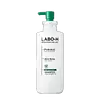What's inside
What's inside
 Key Ingredients
Key Ingredients

 Benefits
Benefits

 Concerns
Concerns

 Ingredients Side-by-side
Ingredients Side-by-side

Water
Skin ConditioningSodium Cocoyl Isethionate
CleansingDisodium Laureth Sulfosuccinate
CleansingLauryl Betaine
CleansingGlyceryl Stearate
EmollientTrihydroxystearin
Skin ConditioningPolyquaternium-10
Caffeine
Skin ConditioningCetyl Alcohol
EmollientDicaprylyl Ether
EmollientSodium Benzoate
MaskingSodium Salicylate
PreservativeMentha Piperita Oil
MaskingMenthol
MaskingCitric Acid
BufferingCaprylic/Capric Triglyceride
MaskingCaprylyl Glycol
EmollientIllicium Verum Fruit/Seed Oil
MaskingRosmarinus Officinalis Leaf Oil
MaskingDextrin
AbsorbentJuniperus Virginiana Oil
MaskingTetrasodium EDTA
Mentha Arvensis Leaf Oil
MaskingEucalyptus Globulus Leaf Oil
PerfumingOcimum Basilicum Oil
MaskingAnthemis Nobilis Flower Oil
MaskingViola Odorata Leaf Extract
MaskingLactobacillus Ferment Lysate
Skin ConditioningGlycerin
HumectantCamellia Sinensis Seed Extract
HumectantTocopherol
AntioxidantCeramide NP
Skin ConditioningHydrogenated Lecithin
EmulsifyingPhytosphingosine
Skin ConditioningBiotin
AntiseborrhoeicWater, Sodium Cocoyl Isethionate, Disodium Laureth Sulfosuccinate, Lauryl Betaine, Glyceryl Stearate, Trihydroxystearin, Polyquaternium-10, Caffeine, Cetyl Alcohol, Dicaprylyl Ether, Sodium Benzoate, Sodium Salicylate, Mentha Piperita Oil, Menthol, Citric Acid, Caprylic/Capric Triglyceride, Caprylyl Glycol, Illicium Verum Fruit/Seed Oil, Rosmarinus Officinalis Leaf Oil, Dextrin, Juniperus Virginiana Oil, Tetrasodium EDTA, Mentha Arvensis Leaf Oil, Eucalyptus Globulus Leaf Oil, Ocimum Basilicum Oil, Anthemis Nobilis Flower Oil, Viola Odorata Leaf Extract, Lactobacillus Ferment Lysate, Glycerin, Camellia Sinensis Seed Extract, Tocopherol, Ceramide NP, Hydrogenated Lecithin, Phytosphingosine, Biotin
Water
Skin ConditioningDisodium Laureth Sulfosuccinate
CleansingCoco-Betaine
CleansingDisodium Lauryl Sulfosuccinate
CleansingDisodium Cocoamphodiacetate
CleansingLauryl Glucoside
CleansingSodium Chloride
MaskingDisodium Cocoyl Glutamate
CleansingNiacinamide
SmoothingPanthenol
Skin ConditioningSalicylic Acid
MaskingCapryloyl Salicylic Acid
ExfoliatingGluconolactone
Skin ConditioningSea Water
HumectantEnteromorpha Compressa Extract
Skin ProtectingSalicornia Herbacea Extract
Skin ConditioningClay Extract
Skin ConditioningSpirulina Platensis Extract
Skin ProtectingCentella Asiatica Extract
CleansingMadecassoside
AntioxidantAsiaticoside
AntioxidantAsiatic Acid
Skin ConditioningGlycoproteins
Skin ConditioningHydrolyzed Keratin
HumectantHydrolyzed Soy Protein
HumectantHydrolyzed Oat Protein
Skin ConditioningHydrolyzed Rice Protein
Skin ConditioningArginine
MaskingCysteine
AntioxidantGlycine
BufferingLysine
Skin ConditioningSerine
MaskingCaesalpinia Spinosa Fruit Extract
Skin ProtectingHelianthus Annuus Sprout Extract
Skin ConditioningPolyquaternium-22
Citric Acid
BufferingMenthol
MaskingPhenethyl Alcohol
MaskingTrihydroxystearin
Skin ConditioningCaprylyl Glycol
EmollientMenthyl Lactate
MaskingSodium Phytate
Hexylene Glycol
EmulsifyingEthylhexylglycerin
Skin Conditioning1,2-Hexanediol
Skin ConditioningMaltodextrin
AbsorbentParfum
MaskingWater, Disodium Laureth Sulfosuccinate, Coco-Betaine, Disodium Lauryl Sulfosuccinate, Disodium Cocoamphodiacetate, Lauryl Glucoside, Sodium Chloride, Disodium Cocoyl Glutamate, Niacinamide, Panthenol, Salicylic Acid, Capryloyl Salicylic Acid, Gluconolactone, Sea Water, Enteromorpha Compressa Extract, Salicornia Herbacea Extract, Clay Extract, Spirulina Platensis Extract, Centella Asiatica Extract, Madecassoside, Asiaticoside, Asiatic Acid, Glycoproteins, Hydrolyzed Keratin, Hydrolyzed Soy Protein, Hydrolyzed Oat Protein, Hydrolyzed Rice Protein, Arginine, Cysteine, Glycine, Lysine, Serine, Caesalpinia Spinosa Fruit Extract, Helianthus Annuus Sprout Extract, Polyquaternium-22, Citric Acid, Menthol, Phenethyl Alcohol, Trihydroxystearin, Caprylyl Glycol, Menthyl Lactate, Sodium Phytate, Hexylene Glycol, Ethylhexylglycerin, 1,2-Hexanediol, Maltodextrin, Parfum
Ingredients Explained
These ingredients are found in both products.
Ingredients higher up in an ingredient list are typically present in a larger amount.
Caprylyl Glycol is a humectant and emollient, meaning it attracts and preserves moisture.
It is a common ingredient in many products, especially those designed to hydrate skin. The primary benefits are retaining moisture, skin softening, and promoting a healthy skin barrier.
Though Caprylyl Glycol is an alcohol derived from fatty acids, it is not the kind that can dry out skin.
This ingredient is also used as a preservative to extend the life of products. It has slight antimicrobial properties.
Learn more about Caprylyl GlycolCitric Acid is an alpha hydroxy acid (AHA) naturally found in citrus fruits like oranges, lemons, and limes.
Like other AHAs, citric acid can exfoliate skin by breaking down the bonds that hold dead skin cells together. This helps reveal smoother and brighter skin underneath.
However, this exfoliating effect only happens at high concentrations (20%) which can be hard to find in cosmetic products.
Due to this, citric acid is usually included in small amounts as a pH adjuster. This helps keep products slightly more acidic and compatible with skin's natural pH.
In skincare formulas, citric acid can:
While it can provide some skin benefits, research shows lactic acid and glycolic acid are generally more effective and less irritating exfoliants.
Most citric acid used in skincare today is made by fermenting sugars (usually from molasses). This synthetic version is identical to the natural citrus form but easier to stabilize and use in formulations.
Read more about some other popular AHA's here:
Learn more about Citric AcidThis ingredient is a cleansing agent, surfactant, and foam booster. It considered an alternative to traditional sulfates (Sulfosuccinate) and is allowed in "sulfate-free" products.
According to a manufacturer, this ingredient is mild and can be used in baby and bath options.
Menthol is a compound found in mint plants, such as peppermint. In its pure form, it is a clear crystalline substance.
Menthol is known for its cooling sensation; however, the cooling is actually from your skin being sensitized. Menthol can worsen rosacea. We recommend speaking with a professional if you have concerns.
Menthol also has antimicrobial properties.
Learn more about MentholThis ingredient comes from Hydroxystearic Acid, a fatty acid, and glycerin. It is used to thicken oils.
Due to its fatty acid content, it is a natural emollient.
Creating trihydroxystearin involves using a chemical reaction between hydrogen and castor oil.
This ingredient may not be Malassezia folliculitis safe.
Learn more about TrihydroxystearinWater. It's the most common cosmetic ingredient of all. You'll usually see it at the top of ingredient lists, meaning that it makes up the largest part of the product.
So why is it so popular? Water most often acts as a solvent - this means that it helps dissolve other ingredients into the formulation.
You'll also recognize water as that liquid we all need to stay alive. If you see this, drink a glass of water. Stay hydrated!
Learn more about Water